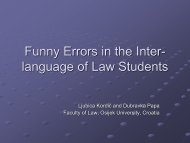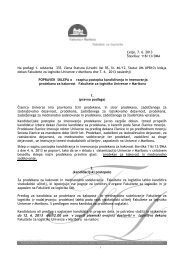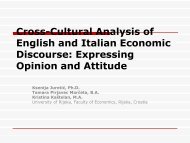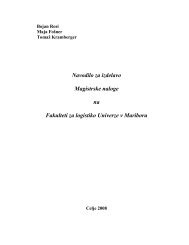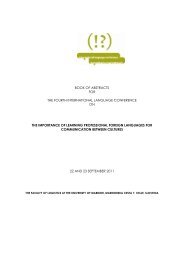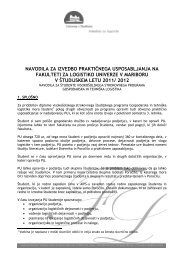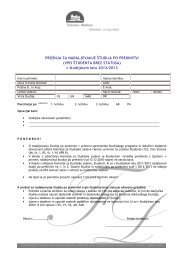AGRICULTURAL ZOOLOGY: NAMES OF INSECT PESTS OF THE ...
AGRICULTURAL ZOOLOGY: NAMES OF INSECT PESTS OF THE ...
AGRICULTURAL ZOOLOGY: NAMES OF INSECT PESTS OF THE ...
Create successful ePaper yourself
Turn your PDF publications into a flip-book with our unique Google optimized e-Paper software.
<strong>AGRICULTURAL</strong> <strong>ZOOLOGY</strong>:<br />
<strong>NAMES</strong> <strong>OF</strong> <strong>INSECT</strong> <strong>PESTS</strong><br />
<strong>OF</strong> <strong>THE</strong> ‘N + V-ING + N’ PATTERN<br />
ANICA PERKOVIĆ<br />
Faculty of Agriculture, University of Josip Juraj Strossmayer in<br />
Osijek, Croatia<br />
aperkovic@pfos.hr<br />
GEORGETA RAŢĂ<br />
Banat University of Agricultural Science and Veterinary Medicine,<br />
Timişoara, România<br />
georgeta_rata@yahoo.com
ABSTRACT<br />
• Well knowing a Language for Specific Purposes is a<br />
subsidiary condition for any member nation of the<br />
European Community. In addition, it can ease<br />
documentary work and communication with world<br />
scientists. This is why we have always needed linguistic<br />
algorithms that allow us to better and quicker understand<br />
literature and/or pairs.<br />
Such a pattern characterises the verbal nouns in -ing that<br />
are often used either attributively or in forming compounds.
Our paper aims at demonstrating that, as far as<br />
the English of agricultural zoology is concerned,<br />
these verbal nouns share the same linguistic pattern<br />
whose counterpart is a similar pattern in Croatian<br />
and Romanian and at advancing a possible<br />
instrument in the teaching of the English of<br />
Agricultural zoology.
INTRODUCTION<br />
The purpose of the present research was to see<br />
if compound common names designating insect<br />
pests in English and built after the same pattern<br />
(‘Noun + Verbal nouns in -ing + Noun’) have or<br />
not a common general meaning.
• Our hypothesis was that this common meaning is<br />
‘insect pest doing something’, and that it could be<br />
useful in the proper understanding and learning<br />
of the insect pest common names in English.
MATERIAL AND METHODS<br />
• We have inventoried a number of 57 insect pest<br />
compound names of the ‘Noun + Verbal nouns<br />
in -ing + Noun’ pattern, which we then analysed<br />
from the point of view of their meaning based on<br />
the following linguistic background:<br />
• nouns ending in -ing are derived from verbs and<br />
express the action of the verb (the art of building)<br />
or its result (a new building), product, material<br />
(cotton wadding), etc. (Soukhanov 2008);<br />
• verbal nouns ending in -ing are often used<br />
attributively (the printing trade) and in composition<br />
(drinking song) (Soukhanov 2008);
RESULTS<br />
First, in our analysis of the insect pest compound<br />
names we focussed on ‘the type of action’ the<br />
insect pests perform. Thus, insect pests (Gordth<br />
and Headrick, 2001):<br />
• bite (5 occurrences) cattle (1 occurrence): cattlebiting<br />
louse ‘Bovicola bovis (Linnaeus): Attacks base<br />
of tail, withers and shoulders’ etc.<br />
• bore (2 occurrences) shoots (1 occurrence): balsam<br />
shoot-boring sawfly ‘Pleroneura brunneicornis (Tohwer)’<br />
etc.
It is interesting to see that the number of the<br />
verbs (22) denoting ‘actions’ of the insect pests<br />
is smaller compared to the number of the<br />
‘objects’ (26) on which these insect pests act<br />
(Table 1).<br />
Table 1. Distribution of ‘acts’ and ‘objects’ in common<br />
names of insect pests<br />
of the ‘N + V-ing + N’ pattern
Object<br />
Action<br />
bite<br />
bore<br />
cast<br />
cut<br />
eat<br />
feed<br />
fold<br />
gnaw<br />
harvest<br />
love<br />
make<br />
mimic<br />
mine<br />
pierce<br />
poison<br />
roll<br />
silver<br />
spin<br />
spot<br />
suck<br />
weave<br />
ants 1<br />
balls 1<br />
banana 1 1<br />
blood 1<br />
bark 1<br />
cases 1<br />
cattle 1 1<br />
dogs 1 1<br />
fruit 1 1<br />
goats 1 1<br />
horses 1 1<br />
leaves 4 6 1 2 3 1<br />
mites 1<br />
mud 2<br />
nets 1 1<br />
orbs 3<br />
pitches 1<br />
roots 2<br />
sap 1<br />
scales 2<br />
seeds 1<br />
sheep 1 1<br />
shoots 1<br />
tubes 1<br />
webs 3<br />
wood<br />
web
RESULTS AND DISCUSSION<br />
• The number of occurrences of ‘objects’ on which insect<br />
pests perform an action is low: 1 occurrence: ant, balls,<br />
blood, bark, cases, mites, pitches, sap, seeds, shoots, tubes and<br />
wood, 2 occurrences: bananas, cattle, dogs, fruit, goats, horses,<br />
mud, nets, roots, scales, and sheep, and 3 occurrences: orbs<br />
and webs. In exchange, the most important part of the<br />
plant – the leaf – records the largest number of<br />
occurrences of all – 17! (table 1)
The 1 ‘action’ – 1 ‘same object’ cases represent<br />
21% of the insect pest common names in our<br />
corpus: African ball-rolling dung beetle, The 1<br />
‘action’ – 2 ‘same object’ cases represent 14% of<br />
the insect pest common names: root eating beetle<br />
and root eating fly. The 1 ‘action’ – 3 ‘same object’<br />
cases represent 16% of the insect pest common<br />
names: leaf-rolling cricket, leaf-rolling sawfly, and leafrolling<br />
weevil;
The 1 ‘action’ – 4 ‘same object’ cases represent 7% of<br />
the insect pest common names: leaf-cutting ant, leaf-cutting<br />
bee, pale leaf-cutting bee, and Texas leaf-cutting ant. The 1<br />
‘action’ – 6 ‘same object’ cases represent 11% of the<br />
insect pest common names: citrus leaf-eating cricket, citrus<br />
leaf-eating weevil, coconut leaf-eating caterpillar, hairy leaf-eating<br />
caterpillar, large leaf-eating ladybird, and lucerne leaf-eating<br />
beetle. The 2 ‘action’ – 1 ‘same object’ cases represent<br />
28% of the insect pest common names: banana silveringthrip<br />
and banana spotting-bug etc.
12<br />
5 5<br />
4 4 4<br />
3<br />
2 2 2 2 2<br />
1 1 1 1 1 1 1 1 1 1<br />
Figure 1 - Number of occurrences of the verbs used attributively in insect pest nouns:<br />
12 eat; 5 bite and suck; 4 cut, roll, and spin; 3 weave; 2 bore, love, make, mine, and<br />
spot; 1 cast, feed, fold, gnaw, harvest, mimic, pierce, poison, silver, and web.
CONCLUSIONS<br />
• Compound common names designating insect pests in<br />
English and built after the same pattern (‘Noun +<br />
Verbal nouns in -ing + Noun’) have a common general<br />
meaning, ‘insect pest doing something’. Our hypothesis<br />
is thus confirmed. In addition, our teaching experience<br />
shows that this common meaning is useful in the<br />
proper understanding and learning of the insect pest<br />
common names in English.<br />
• Additional research could identify other patterns useful<br />
in the understanding and learning of specific<br />
inventories of terms.
THANK YOU FOR YOUR ATTENTION!







